The Journey of A Thousand Beers Begins With a Single Fare
The after work relief, a night out with friends, a crucial playoff game, a casual business meeting, a pre/post interview pick me up, exploring a new part of town, a good time. There are many reasons why us beer lovers appreciate and respect a good watering hole. The Public House or Pub for short is a gathering place. A community oriented nexus of social activity and small business. A place where you can hang out with old friends, or make new ones. A place with good food, exciting sports, fun games, and friendly staff. You won't have to pay a $135 cover for some Bud Light Lime infested, overcrowded sweat joint that plays horribly executed remixes of tasteless pop music. And you certainly won't have any problems hearing yourself think. In fact, the pub is a place for thinkers. A place for ideas. Business models, inventions, political resolutions. Friendship, and love. The pub is a place where you feel welcome to express yourself. And not all pubs are the same. Some are bigger than others, serve more food than others, and play different music altogether. But no matter what your favorite pub(s) are like, they're special. They're a second living room. A second kitchen. And sometimes, a second bedroom. But most importantly, they serve beer. And while clubs and restaurants focus on diluted cocktails and wine respectively, the real pub takes pride in real beer. Good beer. Local beer. And sometimes, beer from far.But what if you don't have a favorite pub? What if you're reading this verbose introduction to some reinvented rapid transit maps, and you have no idea what we're on about? Well fortunately, you've come to the right place. We will be continuously recreating the subway/rapid transit maps of various cities around the world, focusing on the best beer bars and pubs that those cities have to offer. Each station within the network will have its name replaced by the name of the pub or bar/restaurant with the best beer selection nearest to it. The idea is multi-faceted. You get to learn about new places where you can find great beers. Small businesses get their names out for beer lovers to discover. We prefer public transport because while it's not as fun as a car, it's better for the environment, and we categorically oppose drinking and driving (as should everyone, even lawyers). And if you are one of those people who may have moved to a new place recently, or still can't make a decision after years of searching, perhaps this new kind of map will help you narrow that search. As you're probably aware, we'll always encourage you to try new beers. The next one you try could be your new favorite. But there's always something new to try. There's always a new pub to visit, a new part of town to explore. So warm up your subway pass, pick a new place to discover, and go.
Baltimore Pubway Map
Boston Pubway Map
Buffalo Pubway Map
Denver Pubway Map
Montreal Pubway Map
New York City Pubway Map
North Jersey Gold Coast Pubway Map
Rochester Pubway Map
Washington, D.C. Pubway Map
Atlanta, GA, USA
As of May 14, 2014Fried Okra
In many ways, the nexus of the Deep South is unlike any other town in the Bible Belt. Atlanta is known, among many other things, as being the host city for the 1996 Summer Olympics, the origin of Coca-Cola, and the hometown of Turner Broadcasting. The city is regarded as being one of global importance as evidenced by its airport, the Hartsfield Jackson Atlanta International Airport, which has been the world's busiest since 1998. Since its ruination during the Civil War at the hands of Union General William T. Sherman, Atlanta and its surrounding area has transformed the Southeastern United States as it has developed into a major financial, educational, political, economic, cultural, and transport hub for much of the US and indeed, the world. Over 75% of the Global 1000 companies conduct business directly in Atlanta, and the city has the third most Fortune 500 company headquarters of any city in the US. Part of this is owed to Hotlanta's high college degree prevalence, which at 43% is not only miles ahead of the US average of 27%, but also ahead of university rich Boston at 41%. In terms of media and entertainment, CNN (along with the rest of Turner) is headquartered in the city, as well as The Weather Channel, and Cox Enterprises, and until the Thrashers moved to Winnepeg, Atlanta was one of only 13 Cities in the US with a team from all four major professional sports leagues. Culturally, the metro area is still heavily influenced by deep southern heritage, but Atlanta is by far the most cosmopolitan city in the Bible Belt, with a metro population of over 5 million, many of whom are recent immigrants. The ATL has always been viewed as being more "progressive" than the remainder of the heavily conservative deep south. Almost 13% of Atlanta's population has identified itself as part of the LGBT community, boasting the third highest LGBT population in America, behind San Francisco and Seattle. Performing arts as well as contemporary art are very apparent in the city's art scene, and Atlanta's music spans a wide range of genres and artist types from staples country music (Alan Jackson, Kenny Rogers, Sugarland) and southern rock (Allman Brothers Band, Lynyrd Skynyrd), to hip hop (OutKast, T.I., Ludacris), Classical, Christian Rock, and R&B (Usher). And all of this variety and range in taste and diversity, along with a strong economy and a highly educated crowd of art loving, beer drinking cosmopolitans makes for an impressive beer drinking society. Beer drinking is very much at the heart of the American South, despite the south east being home to no multinational macrobrewery. Fortunately, that means that there isn't much of a cheap beer bias like you'd get in Pennsylvania, St. Louis, or Milwaukee. Though asking for a Pepsi at an Atlanta restaurant is more dangerous than ordering a Bud in Milwaukee. In many of The Gate City's bustling neighborhoods, you'll be able to find bars with more than two dozen beers on tap, with real happy hour and plenty of rotational offerings.
The deep south's largest city is served by the Metropolitan Atlanta Rapid Transit Authority (MARTA) and its rail and bus combination. It is the eighth largest system in the US. The system includes 48 miles of heavy rail subway across 38 stations located in several Atlanta Metro area communities. The system opened at the end of June 1979 with the help of a 1% sales tax increase in Fulton (Atlanta) and DeKalb counties. There are four service lines (Red, Gold, Blue, and Green) which converge at the Five Points Station in downtown. The system was created in response to growing urban sprawl and heavily increasing traffic delays on the city's interstate highways. The system and the rest of Atlanta's transport infrastructure was improved in preparation for the 1996 Summer Olympics. Today, 338 rail cars originating from France, Belgium, Italy, and Japan operate every day of the year and transport about 221,000 of the 420,000 passengers that ride the MARTA daily (the rest take the bus). That means that the MARTA has an annual ridership of about 70 million, which is the eighth highest in the US. Despite this, Atlanta is still far behind most other major cities in America with only 11.43% of its commuters utilizing public transport daily.
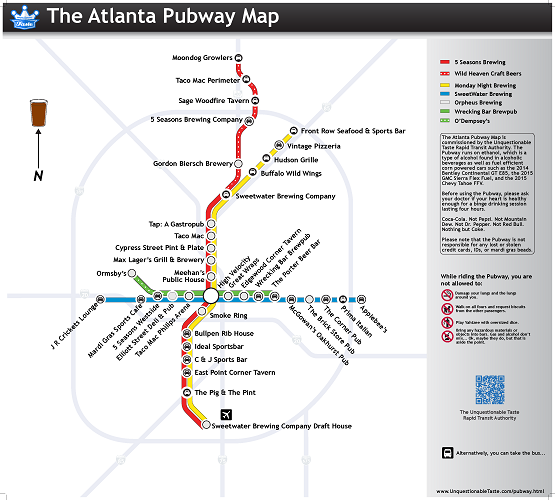
Download the Atlanta MARTA Pubway Map Here
Baltimore, MD, USA
As of December 15, 2014Crab Cake
Located an hour from Washington, D.C. on the Chesapeake's Patapsco River lies the port city of Baltimore, known as "Charm City." Initially inhabited by the Piscataway Tribe of the Algonquins, the land later established as Baltimore City was first colonized by English settlers, who were amicably granted rights to settle by the peaceful Piscataways. Baltimore was officially founded in 1729. Being privileged with access to the 200 mile long Chesapeake Bay, Baltimore grew into an important shipping and trade center, with its population exploding from 14,000 in 1790 to over 430,000 only a century later. Baltimore was the source of inspiration for Francis Scott Key's "Defence of Fort McHenry" during the War of 1812, during the Battle of Baltimore. After Washington D.C. was burned to the ground, Baltimore was attacked by the British, whose Royal Navy bombarded the fort ship cannon fire. The poem would later be adapted into the "Star Spangled Banner," which became America's National Anthem in 1931. Since the 1800s, Baltimore's strategic position along a major shipping route helped it develop into a major port town, becoming a mid Atlantic hub with extensive rail transportation networks including the famous B&O Railroad, the first chartered railroad in the US. Due to its position relative to the Mason-Dixon line, Baltimore's population was torn during the Civil War, creating a setting for short lived, but violent and deadly upheaval. Following the end of slavery in the US, many ex-slaves found a home in Baltimore and over the next century, the local Black American presence and culture would dramatically influence the cityscape and its politics. Tobacco would become a major source of economic power for the region, which shifted development toward manufacturing and industry. During the mid 1900s, the city experienced decades of tumultuous times, especially during the Civil Rights Movement. In 1950, Baltimore's Black American population represented about 24% of the city. By 1970, that number had risen to 46.4%. Meanwhile, many southern whites had moved up north, creating racial tensions throughout the city. Baltimore is regarded by many as the site of the nation's first sit-in, which was conducted by students at a local drug store. Though the sit-in only lasted for less than half an hour, it inspired a wave of desegregation throughout the city. Riots, municipal strikes, a decrease in manufacturing, and neglect to the cityscape had contributed to dark times for Baltimore, which had lost over 200,000 residents over the period between 1950 and 1990. Efforts to rekindle the city's prosperity included building the Baltimore World Trade Center, redeveloping much of the inner harbor which was ridden with abandoned warehouses, constructing the Maryland Science Center as well as the National Aquarium, and relocating the Baltimore Orioles and the Baltimore Ravens closer to downtown. Today Baltimore is an education and health care center, headlined by Johns Hopkins Hospital and University, the two largest employers in the city. Due to its proximity to Washington, D.C., the city has also become a popular destination for many recent college graduates looking for professional employment. About a quarter of the city's job market lies within the fields of math, science, technology, and engineering. One of Baltimore's mottos is "The City That Reads," a testament to the city's massive higher education presence, which besides Johns Hopkins, includes the University of Maryland, Loyola University, Maryland Institute College of Art, the University of Baltimore among others. And with college of course, comes bars and beer. Baltimore itself represents a healthy local brewing market, with examples like Union Craft, Frisco Taphouse & Brewery, Stillwater, Heavy Seas, DuClaw, and Full Tilt Brewing local favorites. Flying Dog based in Frederick, and many D.C. breweries also help make up a strong regional beer market which distributes across the country. Many of Baltimore's beer bars feature rotating cask offerings and some have menus boasting more than 125 individual beers to try. The city hosts multiple crab and beer festivals throughout the year.
The nation's largest independent city and its metro population of over 2.7 million Baltimoreans are served by the Maryland Transportation Administration's MTA Maryland. Almost half of Baltimore's residents go without access to a car, so the region is heavily dependent on the MTA's 80 bus lines, 3 commuter rail lines, and 4 rapid transit lines, known as the Metro Subway and the Baltimore Light Rail. The Subway, despite its name, runs along a 15.4 mile long line which is mostly above ground. There are 100 electrified cars running along the 14 station system, which opened on November 21st, 1983. The trains carry over 51,000 average weekday boardings and about 54 of the 100 cars are used during peak rush hour travel times. The trains can reach speeds of over 70 miles per hour. The Baltimore Light Rail, which opened in April of 1992, is the 19th busiest light rail system in the US, with an average weekday ridership of 27,537. The system has 3 separate lines running along 30 miles of standard gauge track, and is powered using overhead wires. The trains have a maximum top speed of 60 mph and have 1,100 HP each. The MTA owns 53 light rail vehicles and uses between 30 and 35 during typical peak service, and more trains are added for Ravens and Orioles games. There are 33 stations on the Baltimore Light Rail, which was built on streets as well as existing rights of way. Various proposals have been brought to municipal tables with plans to expand rail services and upgrade existing trains, but due to fiscal constraints, no proposals have been pushed through yet.
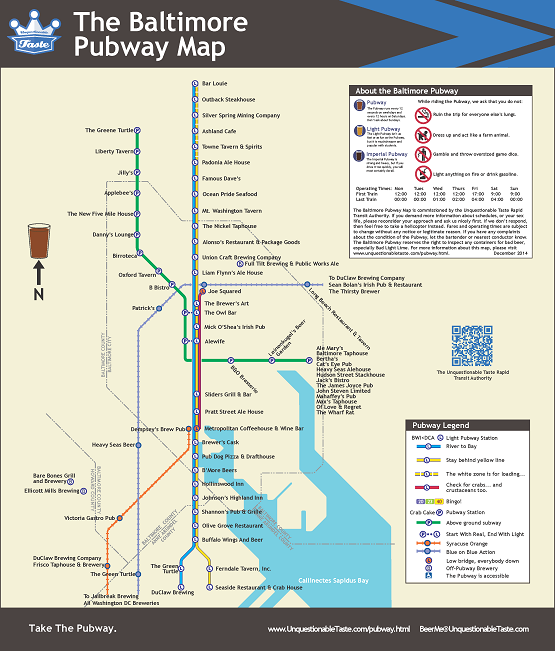
Download the Baltimore MTA Pubway Map Here
Boston, MA, USA
As of February 8, 2014Clam Chowdah
If it weren't for the founders of Boston, America as we know it might not have ever existed. Boston was officially settled by English Puritan settlers on September 7, 1630. If you know anything about American History, you know what took place in the centuries to follow. No taxation without representation. One if by land, two if by sea. The British are coming! Lexington and Concord, the Boston Tea Party, The Battle of Bunker Hill, Paul Revere, The Boston Massacre, the Minutemen, The Siege of Boston, all culminating to the upheaval that would later be known as the American Revolution. The citizens of Boston have always, to this day, had a pioneering mentality which has helped it become a global center of technology, health care, sustainability engineering, and perhaps most notably, education. Mark Twain once wrote, "In New York they ask 'how much money does he have?' In Philadelphia, they ask, 'who were his parents?' In Boston they ask, 'how much does he know?'" The greater Boston Metropolitan area is home to over 100 colleges including Harvard, MIT, Babson College, Boston College, Boston University, Northeastern, and UMass. Each year, the city's population temporarily swells by 250,000 college students. The city is also known for its sports culture, having the distinction of being only one of six American cities to have won championships in all four major sports (Bruins, Celtics, Red Sox, Patriots). Aside from major professional sports, the city is known for, among other events, the Boston Marathon, one of the Six World Majors. The city's love for sports has helped it receive the US bid to host the 2024 Summer Olympic and Paralympic Games. Culturally speaking, The Puritan city is, rather ironically, a very socially progressive place, primed by the area's many universities. The city is a leader in maintaining a sustainable footprint, with many of the city's largest developments gaining LEED status. The city also places a heavy emphasis on renewable energy (mainly wind and solar), and the Massachusetts Water Resources Authority constructed the Deer Island Sewage Treatment Plant in the Boston Harbor in 2000 as part of a $3.8 billion effort to clean up the harbor. The city's progressive culture also leaks into its policy, with a strong modern Democratic history, headlined by the late Thomas Menino, who had served as the city's beloved "Mayor For Life" for 20 years. The city is diverse with many ethnic groups and a vast array of nationalities represented, particularly Irish, Chinese, and Italian. The city is also one of the nation's most LGBT friendly places, having been placed on such lists by many publications. Boston's prominent role in American history has also made it a top tourist destination. Tourists can explore many of the city's main historical sites by following the 2.5 mile long Freedom Trail, a brick pathway that winds through much of Downtown Boston and Charlestown, with stops at notable sites such as the Boston Common, the USS Constitution, the Bunker Hill Monument, Paul Revere's House, Faneuil Hall & Quincy Market, the Old North Church, and the Old State House among others. The self-proclaimed "Cradle of Liberty" is America's 10th largest metro area by population with more than 4.5 million New Englanders. But perhaps more importantly, the central New England region is home to more than 100 breweries of all sizes including more famous craft beer examples such as Harpoon and Smuttynose as well as macrobrews like Sam Adams and a major secondary brewery of Budweiser. Beantown, as we all know from various fictional portrayals in film and music, is full people claiming Irish descent. Yes, it was the Puritans of England who originally founded The Hub, and we can thank Italy for the North End and Tom Menino, but Irish Americans like John F Fitzgerald, Tip O'Neill, and of course, the Kennedys as well as those inhabiting Southie and Charlestown have shaped the area more than any other demographic, especially when it comes to politics and beer. As the area has a rich beer heritage along with the nearby Portland, ME brewing industry, a great deal of emphasis has been placed on providing locals with robust beer menus and tap/cask options at the neighborhood pub. It's common for bars and restaurants to feature more than a dozen or so options on tap, as well as a cask offering and plenty of seasonal brews to boot. Some highlights include Brookline's Publick House, Allston's Deep Ellum, and Cambridge's Mead Hall, all of which have been voted into the nation's best 100 beer bars list regularly. There are plenty of brewpub options as well, like the Cambridge Brewing Company, John Harvard's Brewing House, and local chain Boston Beer Works.
Though Boston is commonly referred to as "The Walking City," with 13% of the city's commuters making the journey by foot, the city also has the fifth highest rate of public transit usage in the US. The MBTA's 65.5 mile long rapid transit system is the nation's oldest subway, having been first put into operation in 1897 with its infamous Green Line light rail system, which is perhaps more famous for its breakdowns and drunk college students than its pioneering achievements in urban transportation. With a daily ridership of 221,900, the MBTA's Green line is the most heavily used light rail line in the US. The system also incorporates three heavy rail lines. The color names of each lines are references to the areas served: Red for Harvard Crimson (the Harvard Square station used to be its Northernmost station), Green for Boston's collection of linked parks known as the "Emerald Necklace", Orange for Orange Street (now Washington Street), and Blue for the Boston Harbor. The MBTA network has 51 heavy rail stations connected to an additional 74 stations on the Green Line, 22 on the Silver Line dedicated Bus Rapid Transit system, and 123 Commuter Rail (purple) stations serving the greater Boston and Providence area. Boston is fifth in the country in terms of transit ridership rate with about 33% of commuters taking rapid transit as opposed to driving or using another means of transportation.
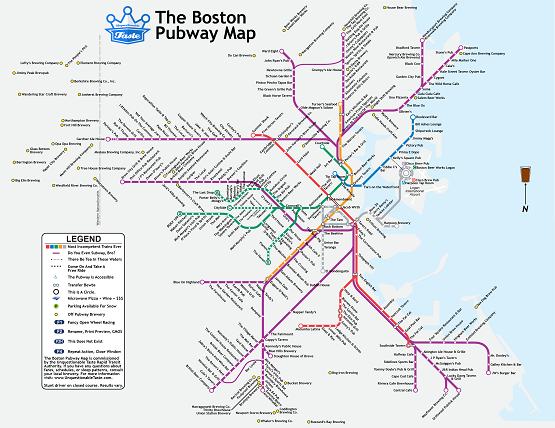
Download the Boston MBTA Pubway Map Here
Buffalo, NY, USA
As of February 19, 2014Buffalo Wing
Though the Buffalo economy's recent history doesn't gleam with iconic fortitude, The City of Good Neighbors' residents definitely do (ask any longtime Bills or Sabres fan). Once the 8th largest city in America, Buffalo has suffered from a near century long contraction which has forced many vital manufacturers and businesses to pack up and leave in favor for better economic (and perhaps actual) climates (the city, located on two Great Lakes, is one of America's snowiest). As a result, crime, urban blight, and unemployment have left massive scars on the once powerhouse of the Niagara River and Erie Canal. Fortunately, there has been some noticeable improvement in the city, with the Western New York region being the recipient of economic investments from both domestic and international corporations, as well as state and federally funded urban renewal projects, including the Steel Winds wind farm (built on top of a former steel mill brownfield), and the First Niagara Center, home to the NHL's Buffalo Sabres among other sports franchises. The city of Buffalo is now an industry center of financial, health, and educational services, and the population has begun to steady out. Beer has always been a big part of the Western New York lifestyle, though the beer scene in Buffalo is still very young and only just beginning to establish itself. Highlight watering holes include Anchor Bar, home of the original Buffalo Wing, and brewpubs Pan American Grill and Pearl Street Grill. But as the region continues to gradually rise from the depths of the Rust Belt era, expect to see even greater things from within its brewing industry.
New York's second largest metro area runs on public transportation served by the NFTA, the operator of the Metro Rail, a single line, 14 station light rail system that runs primarily down Main Street (NYS Rt 5) in the Downtown Buffalo area. The 6.4 mile long line began operation in 1985 and currently sees an annual ridership of more than 6 million passengers, making it the 20th busiest in America by that metric. The service utilizes a fleet of 26 trains built by the Tokyu Car Corporation from Japan. The line has spurred a mini economic rise in the downtown area, with the resurgence of local nightlife and theaters along Main Street. The trains also serve the First Niagara Center for special events like concerts and Sabres hockey games.
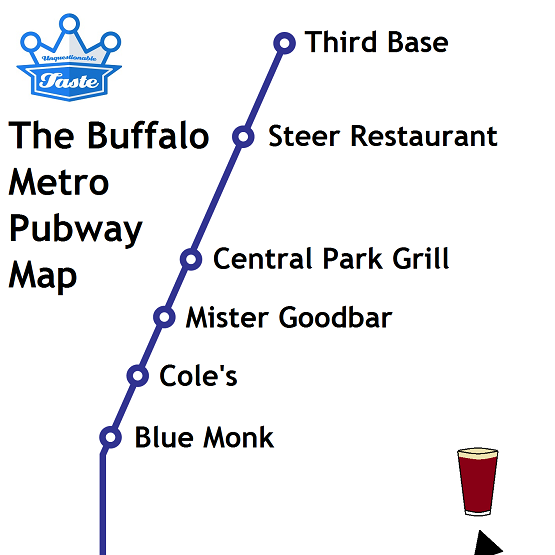
Download the Buffalo NFTA Pubway Map Here
Denver, CO, USA
As of October 19, 2014Rocky Mountain Oyster
Officially standing exactly 5,280 feet above sea level is the Mile-High City. Founded by gold prospectors in the mid 1800s as a Pike's Peak Gold Rush mining town, Denver has since grown from a small fifty-niners settlement into a major transportation and distribution center with strong industry presence in the telecommunications, agriculture, airline, energy, food service, and brewing sectors. The city's geographic location combined with the advent of rail transportation as well as telegraph company Western Union's move to the city in 1863 helped solidify it as a hub for both people and goods through the late 19th century and beyond. In 1870, Denver's link to the transcontinental railroad was completed. Though Denver was hit particularly hard by the silver crash of 1893, it remained at the forefront of progress, driving growth throughout the region. Industry grew through the 20th century, including the construction of the Rocky Flats nuclear warhead plant in 1953. The facility was fraught with problems including radiation leaks, protests, legal troubles, and was ultimately shut down during a tense FBI raid in 1989. The city has had an association with alternative music, as well as folk and of course, jam bands. In 2012, Colorado became the first state to legalize marijuana for recreational use and on New Year's Day of 2014, the first legal pot dispensaries opened to the public. Other places, like the state of Washington have since followed suit. Denver, while being one of only 12 cities in North America with teams from the four professional sports leagues, has the infamous distinction of being the only place in the world to decline hosting the Olympics after it was selected. The city has since attempted to make subsequent bids, but in vain. Still, Denver is a big sports town with a history of success, including two Stanley Cup wins by the Colorado Avalanche led by Patrick Roy and Joe Sakic, and two Super Bowl Championships by the Broncos in the late 90s, QBed by none other than John Elway. The Broncos have managed to sell out every one of their home game since 1970 with the exception of strike replacement games. The city's sports scene has gone hand in hand with its prominent brewing presence, being one of the largest in the country. Coors moved its main operations to the Denver area in 2005 (in Golden, CO), and other well known breweries include Fort Collins, Great Divide, Oskar Blues, Left Hand, and New Belgium. Aside from any mainstays, the Denver area is home to dozens of small scale microbreweries and hosts the annual Great American Beer Festival, which is generally considered to be the biggest and most well known in America. Colorado is ranked as the number one state in the US in terms of gross beer production with 23.4 million barrels produced in 2006. With 161 breweries total, 154 of which are craft breweries, Colorado ranks third in the country with the number of craft breweries in the state and sixth per capita. Because of the strong beer presence, many of Denver's bars are either full on brewpubs or beer bars, specializing in offerings from local breweries. In fact, it is not uncommon to come across bars with more than 100 total offerings including bottled and draft selections.
Despite an ideal sports and beer scene, Mile-High City has business to take care of. Much of the workforce which spurs on Denver's $160 Billion economy is driven by the Regional Transportation District's (RTD) light rail system. Denver had street cars and tram systems in the past, but cars and buses took over their share in the transportation market. In 1994, the city opened its first light rail line (now the "D" line) on Friday, October 7th. At that time, the 5.3 mile long service was run by 11 rail cars and during the first few days of operation (which was free to passengers for the first weekend), it was estimated that more than two hundred thousand people rode the small fleet. Since then, five more lines have been added, and the number of stations has increased to 46 on the 47 mile long system, which is powered using overhead lines. 172 trains now run along the service, ferrying an average 87,000 people to their destination daily, making the RTD light rail the 10th busiest in the US. As a testament to Denver's unique and prominent art scene, each station includes examples of public art which are incorporated into the stations' architectural features. RTD is looking to expand the light rail to accomodate Denver International Airport as well. This is a part of a large expansion to build four commuter rail lines and generally increase accessibility and use of Denver's public transportation via the FasTracks project which will also bring a total six new light rail lines, new bus rapid transit, and other enhancements. The project is estimated to cost $6.5 Billion and is not expected to be fully complete until 2042. Still, the project's first new line to Golden, CO opened in 2013, and the entire project is expected to help drive the economy even further.
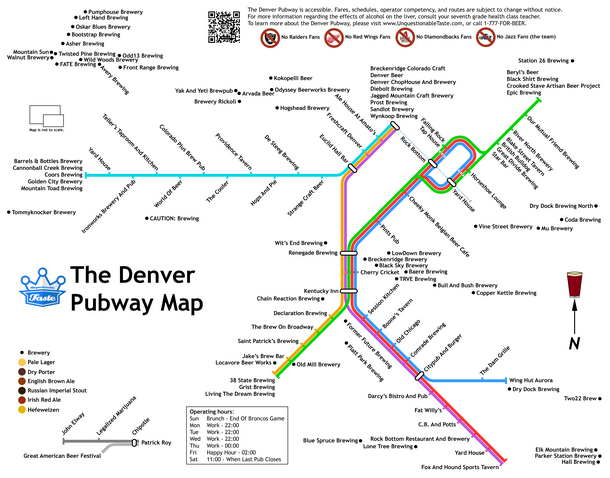
Download the Denver RTD Pubway Map Here
Montreal, QC, Canada
As of July 17, 2014Poutine
Founded on May 17th, 1642 and named after the Mount Royal hill, Montreal is Canada's second largest city, with a population of over 1.6 million "les Habitants." As the largest city in the predominantly French speaking province of Quebec, the city is a center of Canadian culture, a forefront in the tech industry, a financial and commerce capital, and a tourism leader of Canada. Montreal was host to the 1976 Summer Olympics held at "The Big O" and is the home of The Montreal Canadiens, historically the NHL's most successful franchise with a total 24 Stanley Cup championships. Montreal also had an MLB team, the Expos, which played at The Big O stadium until the franchise was moved to Washington DC and became The Nationals in 2004. The Montreal Royals minor league team was the organization where Jackie Robinson first broke the color barrier of professional baseball. The city, the 8th largest in North America, has been designated a UNESCO City of Design and has been ranked as North America's leading host city for international events. Montreal was first settled by natives as early as 2000 BC, who occupied the island of Montreal until the French explorer Samuel de Champlain established fur trading posts on and around the island, which is 192.74 square miles large. Montreal became the capital of the Province of Canada during the 1840s. It remained the capital of Canada until a Tory burnt down the Parliament building in protest of the Rebellion Losses Bill (which compensated Lower Canadians for property losses during the Rebellions of 1837) and the government established Ottawa as its capital for strategic reasons. The development of the St. Lawrence Seaway, which opened in 1959 and bypassed Montreal's waterways, forced the city to focus on other areas of business including pharmaceuticals, finance, and aerospace. The City hosted the 1967 World's Fair (Expo 67), which helped incite development including new highways, the construction of Canada's then tallest skyscrapers, and the Montreal Metro system. The 80s and 90s brought slow economic growth relative to other Canadian cities, especially Toronto, which surpassed Montreal as Canada's economic center in the mid 70s. Since the beginning of the 21st century, Montreal has been experiencing a cultural and economic revitalization. Today, the city is a diverse, vibrant metropolis which appreciates the arts as much as a good beer. The city is regionally famous for its many brewpubs as well as its more prolific breweries including Molson, Unibroue, based in suburb Chambly, and Brasserie Dieu Du Ciel located in the Rosemont neighborhood, also home to Montreal's Little Italy. Montreal's Chinatown , like New York City's, is close by in an adjacent neighborhood, Quartier Latin. The city is still an economic center, with companies like Canadian National (Canada's largest railway), Bombardier, Bell Canada, The Royal Bank of Canada, Air Canada, and many others all headquartered in the city. The city is also considered to be "Canada's Cultural Capital," with a prominent movie industry, a plethora of festivals celebrating music and art, and celebrated groups like Cirque du Soleil and the Montreal Symphony Orchestra. Aside from the city's skyscrapers, Montreal's most famous architecture comes in the form of its many prominent churches. Nicknamed "la ville aux cent clochers" (the city of a hundred steeples) Mark Twain once noted that in Montreal, "you couldn't throw a brick without breaking a church window."
Montreal is the second largest primarily French speaking city in the world after Paris, whose famous Metropolitan rapid transit system was used as the model for Montreal's STM Metro. The Montreal Metro system, including the primary metro rapid transit network plus the 197 main bus routes and the 23 night bus routes, is the fourth busiest system in North America, with Toronto being second. The actual rapid transit system, simply known as "Metro de Montreal" is a rubber tired train system which carries an average 1.25 million unlinked passenger trips per day, making it the third busiest in North America after New York and Mexico City. The metro system was opened on October 14, 1966 with 26 stations on three lines. Today, the system covers 43 miles of track with 68 stations and is driven by 759 rubber tired train cars. The cars themselves, many of which are originals from the 1960s are not air conditioned because the heat caused by the ac units and built up inside the tunnels would have presented an even larger problem since the entire system is built underground. These are among the oldest subway train cars in North America. STM (Societe de transport de Montreal) is slowly, but gradually upgrading the rolling stock of the metro to include more modern, air conditioned trains which have an open layout and interconnected cars, which allow passengers to walk from one car to another freely, like the system in Barcelona. The replacement of the trains is expected to start in the spring of 2014 and take place until all of the trains are replaced. The first transit system in Montreal was a horse drawn streetcar system, which fell victim to urban congestion, sparking proposals for a subway in as early as 1910. Since opening in 1966, the network has been gradually expanded to incorporate more of the surrounding suburban areas of the city. There are current proposals to expand the Orange line, the Yellow line, and the Blue line to further increase the system's utilization per capita, which is only second in North America to the Big Apple. Many of the stations feature large scale works of art and stained glass. Seven of the stations are connected to Montreal's underground city, RESO/La Ville Souterraine. Like Toronto, which also has an underground city, Montreal's network of underground shopping malls and public spaces is used especially in winter to escape the sometimes harsh Canadian winters. And also like Toronto's PATH, RESO is one of the largest underground complexes in the world. The complex opened in 1962 and covers over 4.6 square miles of floor space connected by over 20 miles of tunnels.
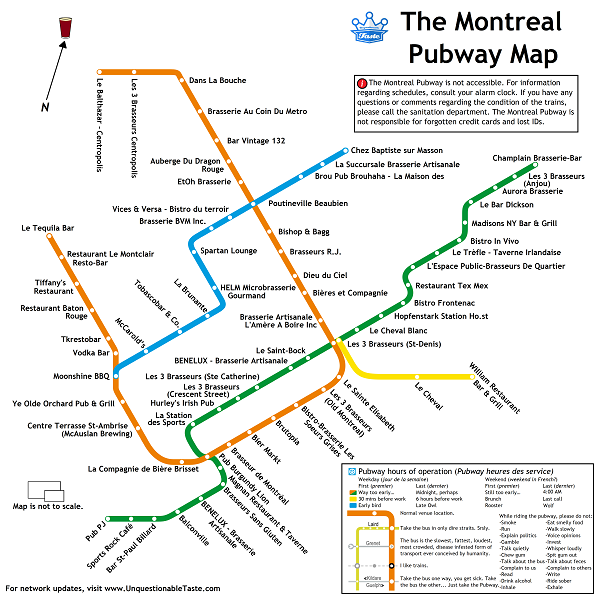
Download the Montreal STM Pubway Map Here
New York City, NY, USA
As of January 24, 2015Hot Dog
They say if you can make it here, you can make it anywhere. And though the headlines of news since the financial crisis constitute a torrent of seemingly endless destitution, that isn't to say that the descendants of those whose first sight of America was the Statue of Liberty can't, at least with a bit of luck, turn what little they have, into an empire. New York City is a history of those with little coming out on top. In fact, the city itself was a bit of a success story, at least for some Dutch settlers. But before they had arrived, the first European to discover the harbor was Giovanni da Verrazzano from Florence, who in 1524, first claimed the surrounding area as part of France for whom he was exploring for. Today, his name lives on in the form of America's longest suspension bridge, the Verrazzano Narrows bridge, which links the boroughs of Staten Island to Brooklyn at the mouth of the New York Harbor. Since 1976, the bridge has marked the start of the New York City Marathon. From there, the Spanish and Portuguese had discovered even more beyond the harbor, helping in 1527 to create the first world map to show the North American east coast continuously. From there, Dominicans were the first non-Natives to settle in what would eventually become New York City, and it was a Wallonian man named Peter Minuit who would make the famous 60 Guilder purchase for the island of Manhattan. Today, the 60 Guilder (now defunct because of the Euro) amount equates to roughly $1000 USD in today's money, which, when compared to the $3 Trillion real estate value of the island currently, means that this was, and probably ever will be, the biggest sucker/success story ever. Once New Amsterdam had been settled, the city's population boomed as a major trading port for the British. The area now forming modern day Brooklyn was the site of the Battle of Long Island, the largest battle in The American Revolutionary War. The development of the Erie Canal helped establish New York and the rest of what would later become New York State into a major economic center for the new nation, which, thanks to the high influx of immigrants, became the world's largest urban area in 1920. Due to the Great Irish Famine, and various revolutions in Germany, Irish and German immigrants comprised 50% of New York's population in 1860. New York City would ultimately become a major gateway for immigrants coming to America, which for many, would first make its appearance in the form of the Statue of Liberty. Furthermore, New York was a primary destination for many Black Americans making their way up from the south during the Great Migration. In 1916, New York had the largest African urban diaspora in America, and this helped spur the Harlem Renaissance during the 20s, which was characterized by a flourishing era of literary, musical, and cultural significance during Prohibition.
Despite the Stock Market Crash of 1929 and the resulting Great Depression, the early 1900s made its visual and physical impact on the city with its extremely large concentration of high rises, including all of world's largest and tallest buildings at the time. These included 1909's Met Life Tower, 1913's Woolworth Building, 1930's Manhattan Trust Building & the Chrysler Building, and of course, 1931's Empire State Building, all of which were the tallest in the world at the time they were completed. The 103 storey Empire State Building, standing at 1,454 feet tall, held the title as the world's tallest until the 1971 topping out of the North Tower of the World Trade Center, less than four miles to the south. The twentieth century meant nothing but tumultuous times for the city, which began in a more tragic way. In 1904, a steam ferry named the General Slocum caught fire and sank, taking the lives of more than 1,000 of its passengers. It remained the deadliest event in New York's history for nearly a century. Seven years later, 146 garment workers died in the now famous Triangle Shirtwaist Factory fire, as a result of poor working conditions, a lack of adequate fire loss prevention, and the absence of available dedicated emergency egresses and stairwells. This, combined with the fact that the factory owners deliberately locked the doors to prevent the workers from taking unauthorized breaks, lead to new, improved global standards in workplace (especially factory) safety, as well as the creation of the International Ladies' Garment Workers' Union. Later, the city would experience unprecedented hardship in the form of the Great Depression, with swift changes in the political landscape following. The 40s, 50s, and 60s cemented New York's place as a global megacity, with the construction of the UN Headquarters Building in 1952, and the rise in expressionist art which precipitated the city's displacement of Paris as the world's art capital. In 1969, the Stonewall Riots which took place in Greenwich Village, helped lead the fight for gay rights in both the city and the United States. Today, they are collectively considered the single most important event leading to LGBT rights in the US. The 1980s saw some of the highest crime rates in the city's history, until changes in police strategies gradually ameliorated this throughout the 90s. While the early 2000s brought a mix of Wall Street spikes and troughs, the world was changed forever when, on Tuesday, September 11th, 2001, terrorists linked to Al-Qaeda hijacked four jet airliners and deliberately crashed them into various sites in the Northeast, including both of the twin 110 storey buildings of the World Trade Center. 2,996 people were killed in the attack. The role of transportation & public security, the global political landscape, modern architectural engineering, broadcast news media, and the identity of New York City would never be the same. But even as a gaping reminder of the city's own vulnerability would remain for years, the city and Lower Manhattan would eventually recover, with the official opening of 7 World Trade Center in May of 2006. Aside from this building, the overall reconstruction project would be as complicated socially and politically, as it would be expensive. Construction on the main parts of the complex wouldn't begin until five years after the attacks, leaving 16 acres of the world's financial center void of much needed recovery. There was a great deal of controversy surrounding the new complex's design, but eventually, an all-glass and steel array of contemporary and post-modern style high rises surrounding a newly constructed shopping mall, memorial, museum, and transportation hub was chosen. The new focal point of the complex, One World Trade Center, officially opened on November 3rd, 2014 after a building cost of $3.9 Billion, and 8 and a half years of slow, sometimes disrupted construction. It was the most expensive building in the world at the time of its opening. Standing at a symbolic 1,776 feet tall, the 104 Storey supertall skyscraper is the tallest in the Western Hemisphere. Construction of towers 2 and 5 are on hold until more tenants can be found, tower 4 was opened only ten days after tower 1, and tower 3 is underway and expected to be completed sometime in 2017.
Today the city continues to be a leading global center for art, media, real estate, cuisine, finance, technology, transportation, architecture, advertising, fashion, music, retail, and education. Its entertainment industry is headlined by the world famous Broadway theaters in Midtown,of which over forty contain at least 500 seats, while Brooklyn continues to be a alternative and indie music crossroads. Over 500 art galleries bring color and expression to the city, and the city has over 4,000 mobile food vendors in addition to its 24,000 health inspected restaurants. New York Holds the distinction of being one of the only five cities to have won championships in all four major professional sports leagues, and only one of two cities to have also won a major soccer title as well (Chicago being the other). Four of the ten most expensive stadiums ever built lie within the New York Metropolitan area, and the city is home to more major professional teams than any other city with the Islanders, Rangers, Devils, Giants, Jets, Yankees, Mets, Nets, and Knicks all within the area. The city is also home to many of the world's most famous politicians, sports figures, actors, musicians, and other celebrities. And aside from the glitz and glamour of the city being what it is, New York is also home to many large and small Breweries which distribute their products via many of the country's best beer bars that exist within the city. New York's night life and bar scene is a separate world on its own, but on the quieter, non-club side, people who find themselves in the neighborhoods of Astoria, Atlantic Yards, the Financial District, the East Village, Hell's Kitchen, and Greenpoint will be especially happy with the craft beer options offered on tap.
North America's largest metropolitan area has a GMP of roughly $1.5 Trillion, which is outranked by the GDPs of only 11 nations around the world. Everything in New York is like everything in many other major cities... but bigger. Taller buildings, inflated egos, fatter tourists, wider streets, higher prices, louder voices, and a more immense rapid transit system. The largest city in America is largely transported on the Metropolitan Transportation Authority's (MTA) famous New York City Subway system. The network has been delivering passengers to four of New York's five boroughs (Staten Island has its own train run by the MTA, but is not physically connected to the rest of the system) since it first opened as a railway network on October 9th, 1863. With over 1.7 billion annual rides, the MTA Subway is the busiest rapid transit system in the Americas and the seventh busiest in the world. It is one of the only systems with 24 hour service and, with 468 stations currently in operation, the system is the largest in the world by that metric. The network runs along 34 lines with a total 842 miles of standard gauge track, and is serviced by 6,384 cars. The quintessential unpainted silver subway cars, the old stations, the elevated sections of 40% of the system's track, and sprawling map used to navigate it all, make the subway an iconic landmark in its own right among the dynamic New York landscape. Currently under construction is the $17+ Billion Second Avenue Subway, which will add 8.5 miles of dual track across 16 new stations on the east side of Manhattan. This map will be updated once the line is operational. The subway uses other rail connections to access the three major airports of the Greater New York area, as well as all of the major sports venues of the city, including the new Atlantic Yards' Barclays Center, home of the New York Islanders and the Brooklyn Nets. The arena was constructed on top of the Atlantic Yards Station, named for the numerous train tracks there, and serves as the transport hub for the A, C, G, F, D, N, R, 2, B, Q, 5, 4, 3 subway lines, and the LIRR. Over the years, the subway has gained a reputation for art, especially music, which often fills the long corridors of the system's busiest stations. Since 1987, the MTA has sponsored the "Music Under New York" initiative, where both established as well as aspiring artists enter a competitive contest in order to gain access to perform and practice in high traffic areas. On a given week, 100+ MUNY associated musical acts will participate in over 150 performances at 25 high traffic locations throughout the system. There are certain regulations and rules concerning the safety and content of the performances, but overall, any artist is free to perform as long as they are not interfering with general transit activities, regardless of whether they are affiliated with the MTA's MUNY program. The rolling stock is comprised of a potpourri of trains of various sizes and cars as old as 1964, and as new as 2015. The cars themselves are mostly unpainted exposed stainless steel, except in certain ceremonial or historic cases. In 2012, the MTA placed a $599 Million order for 300 new cars from Canadian Manufacturer Bombardier, with the first test train of ten cars arriving in 2015. It will also be announced later in the decade that hundreds of newer cars will be ordered to replace many of the outdated fleet as well as expand the current fleet for the upcoming Second Avenue Subway. Despite historical issues with crime, litter, an outdated infrastructure, flooding, and noise complaints, the New York City Subway is considered to be one of the most complicated, expensive, and impressive human engineering endeavors of all time.
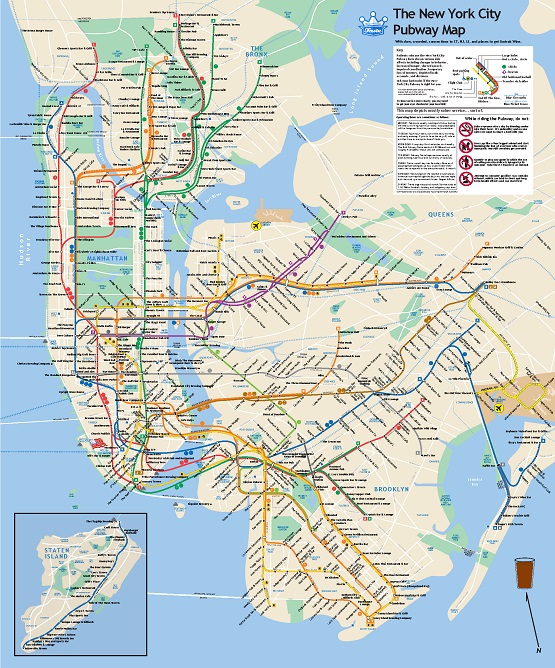
Download the New York City MTA Pubway Map Here
North Jersey Gold Coast, NJ, USA
As of August 23, 2014Tomato Pie
If you want a glimpse of the best view of New York City, don't wait 15 hours in line to head to the top of the Empire State Building. Just pay the $2.75 fare on the PATH, and head to New Jersey. Specifically, head to the general area of North Jersey between Fort Lee, where the George Washington Bridge is, and Jersey City. This area, known as the "Gold Coast," contains the communities of North Bergen, Hoboken, West New York, Secaucus, and Edgewater, among others. Separated from Manhattan by the Hudson River, this highly densely populated area has always been blessed with tremendous real estate potential, thanks to its imperial neighbor to the east, but its rollercoaster history would have you believe otherwise. At the turn of the 20th Century, the city of Hoboken was known for its vibrant German community, a rather prosperous aspect of the cityscape that helped shape the area into an important industrial center for New York City. Hoboken was also the place where the first recorded game of modern North American Baseball was played between the Knickerbocker Club and the New York Nine. Many Italian and Irish moved to the area looking for work at the shipyards while the rest of the metro area was being dragged down by the Great Depression. At the height of the two World Wars, demand for military equipment and manufacturing helped keep Hoboken steaming ahead. The North Jersey area was also helped with massive public works projects like the Lincoln and Holland tunnels. Many large companies had corporate presence in the area, and overall pay and employment rates were good. In the 1960s, however, things started to deteriorate. As the car, truck, bus, and even the plane began replacing ships as a way to move people and things, demand for ship building left, and many of the area's largest employers closed down factories, seeking cheaper locations outside of the city. Many of the area's wealthier residents left for the suburbs, and the cities of Hoboken, Paterson, Jersey City, and Newark began a downward economic and social spiral. The population was on a steady decline for three decades. Crime, especially violent crime spiked in the 70s, while blight, arson, wild dogs, and theft was commonplace, and overall, the economy showed no real signs of improvement. Landlords also charged exorbitantly high rent, which increased the prevalence of income inequality. It wasn't until the mid 80s to early 90s that things began to turn around. Being located directly across from the largest economic center in North America, real estate was always going to underpin the North Jersey economy. General speculation and ultimately, gentrification helped spur a cultural and social movement in the area, which quickly became known for its younger, highly educated commuter crowd. This demographic not only brought in much needed money into local business, but also a hip and trendy art, culture, and gastropub filled hipster breeding ground. The area, which is connected to the rest of North Jersey and New York with a vast array of highways, rail, ferries, and tunnels, is now bursting with tall luxury condo high rises, glistening glass clad corporate head offices, gourmet restaurants, and high end shopping. The median family income in Hoboken exceeds $120K. And all of this nouveau riche development is increasing the demand for upscale bars, where not only are gin based cocktails are carefully crafted by high paid mixologists, but expensive, local no name beer is served from casks. There are no prominent breweries in the area, but appreciation for high quality craft beer is as lofty as the prices for its luxury condominiums.
The New Jersey Hudson Waterfront is served locally by a relatively new light rail system known as the NJT Hudson-Bergen Light Rail. With its first phase opened in April of 2000, the HBLR is part of an overall scheme to increase economic activity in Jersey's Gold Coast. Demand for the system grew as the area, especially Hoboken became more prosperous following the real estate rise in the 80s and 90s. It was decided that in order to reduce congestion, especially around the Lincoln and Holland tunnels, a light rail system built along the land below the palisades would get the job done. The first section ran between Bayonne (Blue Line) Exchange Place, and the West Side Avenue station at the end of the Yellow Line. Two years later, this was extended to the Hoboken Terminal, which is parallel to Manhattan's midtown. Four years later in 2006, the project was extended to Tonnelle Avenue in North Bergen. The entire system as it exists today is 21 miles long and serves just under 50,000 weekday passengers, making it the 13th busiest light rail system in the United States. The three line system is driven by 52, 90 feet long electrically powered trains built by a Japanese manufacturer. These are the same type of trains that the Newark, NJ system uses. Some of the tracks used are old freight railway rights of way that have since been transferred. There are a number of proposed expansions that run on other rights of way that are being debated locally. The system runs through 24 stations in six communities, and at a cost of $2.2 billion to create, the current system was one of the largest public works projects in the history of New Jersey.
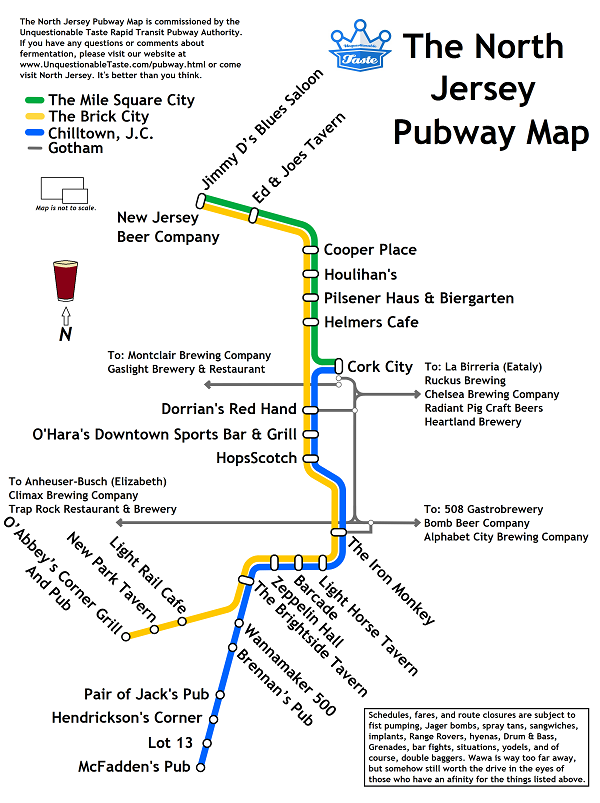
Download the North Jersey NJT Pubway Map Here
Rochester, NY, USA
As of May 16, 2014Garbage Plate
When the late 2000's recession was wreaking havoc especially in areas like Florida, Nevada, and the Southwest, much of the Great Lakes region remained little changed for the most part. And that is because of the origin of the less than affectionate title, "Rust Belt." At the height of the economic boom of the Great Lakes region, Rochester was a manufacturing center with international companies like General Motors, IBM, Eastman Kodak, and Xerox all maintaining a huge presence in the city. But a series of economic downshifts, high state taxes, increasing labor costs, and other factors forced many of these jobs out of the region, creating large gaps in industrial development, leading to lost jobs, depressed economies, crime, brownfields, and ultimately, the moniker Rust Belt. Fortunately, as we're seeing in Buffalo, Rochester has been on a gradual, but steady trend of improvement since the trough of economic decline. Xerox and Kodak still represent major employers in the area, but the focus has turned to more research and high tech jobs. The city's area colleges and universities are internationally recognized for their engineering, healthcare, and education accolades, and the population, as well as jobs, are slowly growing. The Flour City is New York State's third largest city, and is located at the nexus of the Erie Canal and the Genesee River, just south of Lake Ontario. About equidistant from Buffalo and Syracuse, the city is also the third snowiest in America, receiving much of its frozen precipitation thanks to Erie and Ontario based Lake Effect Snow. Aside from the Erie Canal, the city's history is also highlighted by abolitionist, newspaper North Star founder, and orator Frederick Douglass, who had lived in Rochester for over 25 years, film & photography innovator and entrepreneur, George Eastman who founded the Eastman Kodak Company, and women's suffragist and abolitionist, Susan B. Anthony, who, with Elizabeth Cady Stanton, founded the National Woman Suffrage Association, the American Equal Rights Association, and whose efforts ultimately led to the 19th Amendment to the US Constitution, giving women the right to vote. Various publications have claimed Rochester as a top ranked city by many metrics, including the third best place to raise a family by Forbes, the top ranking for overall quality of life for US cities with more than 1 million people, & the sixth best public schools in the country by Expansion Management Magazine, the "Most Livable City" in the country by Places Rated Almanac, and Kiplinger's fifth best city for families. That all said, the Flower City, also known for its annual Lilac Festival, is still very much in a recovery era like the remainder of the Great Lakes region. Still, the economy of Rochester has seen a consistent stream of service and technology related jobs with companies like Bausch & Lomb, Paychex, ESL Credit Union, Constellation Brands, Gleason Works, and Carestream Health maintaining their headquarters in the Rochester Area. Another steadily growing industry in the area is brewing. Headlined by the Genesee & Dundee brands' owners North American Breweries, Rohrbach, and Three Heads Brewing, the Rochester area beer scene has seen a new investment in startup microbreweries which have been able to thrive in less than stellar economic conditions. The Rochester Rhinos USL soccer team's stadium, Sahlen's Stadium has hosted the Empire Beer Festival, and the city is home to the annual Craft Beer Expo, as well as the Rochester Real Beer Expo, and the RocCity Brewfest, among other festive industry gatherings. The Rochester Real Beer Week celebrates the city's bars, breweries, food, and neighborhood revival in a week long city wide festival where people can try local beer, enjoy pig roasts, test food pairings, and vote on things like the best happy hours, brunches, and chicken wings. Draft specials and beer tastings also take place at various venues in neighboring towns outside of the city during the week. The event has also attracted well known out of state brewers like Harpoon, Victory, Spoetzl, Sam Adams, and Sierra Nevada.
On October 26, 1825, the Erie Canal opened for commercial travel by mule driven barges. It is regarded as the most important man made waterway in North American history, and is credited with inciting the development of lands west of the original 13 colonies in the 1800s. Also considered a civil engineering marvel and landmark achievement in public works, the Erie Canal was originally 363 miles long (it has since been expanded) and traveled over four aqueducts. Perhaps the most famous aqueduct was the Erie Canal: Second Genesee Aqueduct which traversed over the north flowing Genesee River in downtown Rochester. Rochester was one of the cities which witnessed a massive surge in population following the development of the canal. As part of a series of system upgrades and expansions, the canal was rerouted in 1918 to its present day route outside of the downtown area, and the bridge, now known as the Broad Street Bridge, had a road deck added on top of it, carrying present day Broad Street. The former Aqueduct and the remainder of the former canal section was then converted into the Rochester Industrial and Rapid Transit Railway, more commonly referred to as the Rochester Subway. The single line rail system was more of a light rail that was only partly underground. Running from the General Motors plant near Mt. Hope to the suburb of Brighton, the Rochester Subway was a connection between home and work for many Rochesterians before it closed in 1956, when it was replaced by the automobile and present day I-490, known then as the Eastern Expressway. Much of the tunnel was still used by manufacturers in the area, including GM and Gannett Newspapers, founded and headquartered in Rochester, who used the tunnel for freight operations until moving out of the city in 1996. Following the full closure of the subway in 1996, the city needed to make a decision on what to do with the remaining infrastructure, as it was costing the city about $1.2 million a year to maintain it. Various proposals were floated, including the rerouting of the Erie Canal back to its original route through the city. Another proposal would have brought rapid transit back to the city after more than half a century, and if it weren't stopped by public outcry, the city would have simply filled in the subway tunnel. A final decision has yet to be made, but the city will most likely maintain part of the subway as a transportation museum and downtown walkway between the AHL Rochester Americans' home ice, The Blue Cross Arena, and the convention center on the other side of the Genesee River. Rochester is served by the Regional Transit Service bus network. 6.83% of daily commuters in Rochester take public transport, placing it 50th in the country. Advocates claim that the local economy as well as commute times would improve with the implementation of a light rail rapid transit. This special map includes various extension proposals, many of which run on existing railroad rights of way, and illustrates what the subway could have looked like if it was still in operation today.
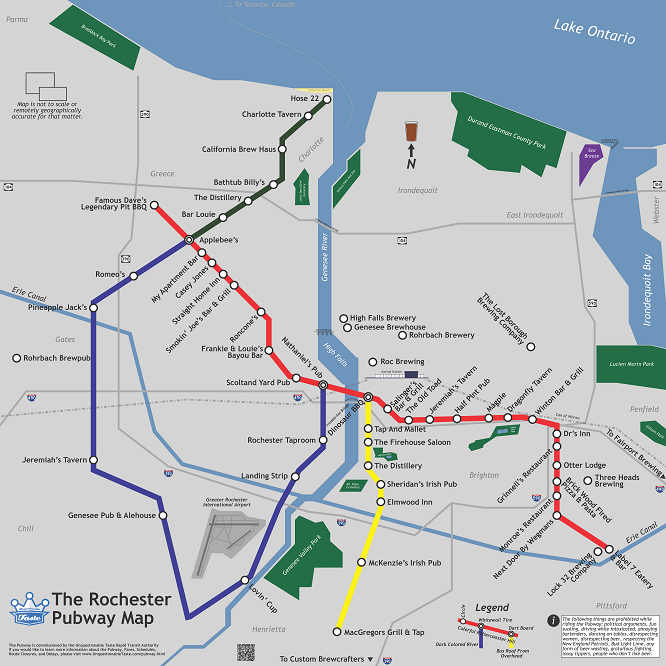
Download the Rochester RGRTA Pubway Map Here
Washington, D.C., USA
As of February 27, 2014Half-Smoke
It should come as no surprise that the capital of the world's richest and most powerful nation has one of the best beer scenes on the East Coast. Much of that is probably owed to the way our beloved Congress (clusterintercourse) has been performing; rational minds down there need good beer to cope. The American Rome is the center of the country's seventh largest metro area which, aside from politics, is famous for traffic, crime, a lack of citizen representation, building height restrictions, and lackluster sports franchises, all of which are even more reasons for what can only be described as a prime location for a prolific regional brewing industry. Of course, having access to wonderfully crafted local beer helps with increasing overall quality of life (at least in our minds it does). In fact, the former "Murder Capital of America" has the second highest health insurance participation rate in the country thanks to municipal programs which help give insurance to lower income residents. The city is also listed as the 37th best place in the US for business and careers by Forbes, and with an unemployment rate of only 5.4% thanks in part to steady regional job growth, the city (along with neighbor Maryland) has recently become a top destination for recent college grads starting their careers. And with students and recent grads comes, well... beer. And with all of these yuppies with elevated amounts of disposable income, only high quality, free range, organic, non-gmo, locally sourced, goods crafted with power exclusively generated by ethically constructed wind turbines not placed near bird migration paths, and sold by pastel green Prius driven non-profit 501(c)(3) organizations who give all of their money to illiterate, Humvee burning tie-dye colored polar bears with chronic cholera will do. That, or some wholesome, American, non macro craft beer. And fortunately for all of us, especially us humans, the City of Magnificent Intentions is spoiled for choice when it comes to the local brews. Aside from American Craft Beer Festival participants DC Brau and Franklin's Brewery & General Store, the capital is home to many other brewpubs including Right Proper, Beltway, Three Stars, Capitol City Brewing, Atlas, Bayin Hound Aleworks, District Chophouse, and Bluejacket, in addition to regional options Heavy Seas, Dogfish Head, and Flying Dog. And with all of this choice, dozens of the city's bars serve 20+ offerings on Tap.
The District of Columbia is home to some of the worst traffic in the country, which is remarkable because more than 38% of the city's commuters take the famed WMATA Washington Metro to work. The system, which was opened in 1976, covers 106.3 miles, with 86 stations on five lines and is served by 1,126 electrified train cars. In 2012, the network's annual ridership exceeded 280 million, making it the second busiest in the country behind the New York City Subway. The rapid transit system is noted for its cleanliness as well as its vaulted ceilings which serve as a general homage to Neoclassical Architecture commonly found within The District. Many of the lines make use of interlining, meaning that multiple services run on the same tracks which can make getting around easier, or more difficult depending on where you are and where you're going. A unique feature of the underground portion of the network is the depth at which many of the stations are built below ground level. The Wheaton station's escalators are 230 feet long, which make them the longest in the Western Hemisphere and other long escalators include those at Rosslyn and Dupont Circle. The deepest station is Forest Glen, which contains no escalators and is instead served by high speed elevators. And despite the high usage of the system, DC's rapid transit network is not connected to the small underground United States Capitol Subway System, which connects the Capitol Building with the offices of the House and Senate, an omission which probably helps the stations and trains stay clean.
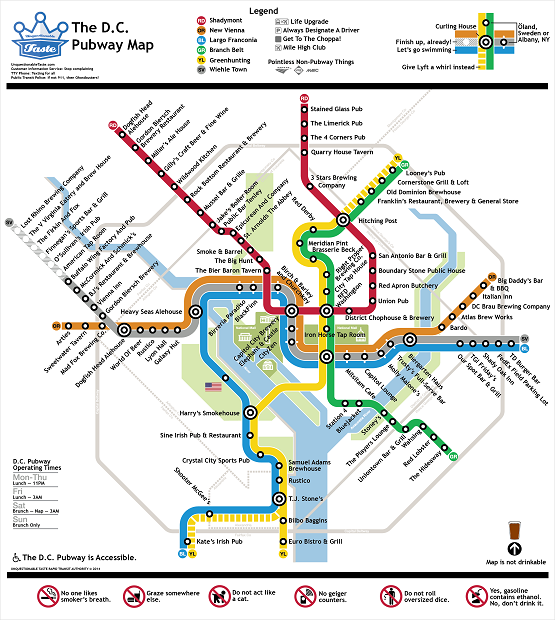
Download the WMATA Washington Pubway Map Here
Upcoming Pubway Maps
Philadelphia, PA, USASan Francisco, CA, USA
Proposed Pubway Maps
Dallas/Fort Worth, TX, USAChicago, IL, USA
Seoul, South Korea
London, England, UK
Copenhagen, Denmark
The Hague, Netherlands
Toronto, Ontario, Canada
Berlin, Germany
Geneva, Switzerland
Minneapolis/St. Paul, MN, USA
Blackpool, England, UK
Munich, Germany
Las Vegas, NV, USA
Warsaw, Poland
Hong Kong, China
Norfolk, VA, USA
Helsinki, Finland
Memphis, TN, USA
Istanbul, Turkey
Moscow, Russia
St. Petersburg, Russia
Little Rock, AR, USA
Singapore
Frankfurt, Germany
Budapest, Hungary
Rio de Janeiro, Brazil
Glasgow, Scotland, UK
Brussels, Belgium
Dusseldorf, Germany
Phoenix, AZ, USA
Kyoto, Japan
Minsk, Belarus
Vienna, Austria
Miami, FL, USA
Incheon, South Korea
Athens, Greece
Orlando, FL, USA
Cairo, Egypt
Vancouver, Canada
Charlotte, NC, USA
Lisbon, Portugal
Madrid, Spain
San Diego, CA, USA
Cleveland, OH, USA
Los Angeles, CA
Rome, Italy
Bern, Switzerland
Milan, Italy
Sapporo, Japan
Antwerp, Belgium
Rotterdam, Netherlands
Tokyo, Japan
Kiev, Ukraine
3 Newcastle, England, UK
Busan, South Korea
Zurich, Switzerland
Oslo, Norway
Stockholm, Sweden
Barcelona, Spain
Beijing, China
Amsterdam, Netherlands
Prague, Czech Republic
Paris, France
Among others...
Don't see a map here that you want created? Let us know, by emailing us or by ranting about something you dislike in the comments section under this...
 UqT Rapid Transit Pubway Authority Maps
UqT Rapid Transit Pubway Authority Maps




